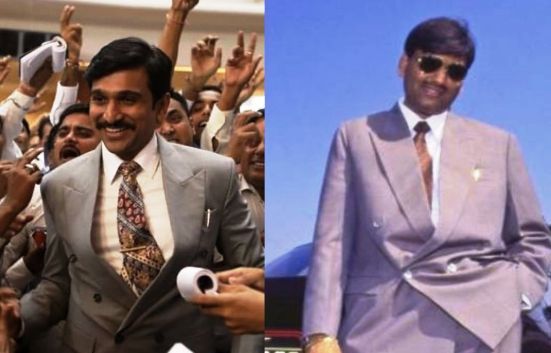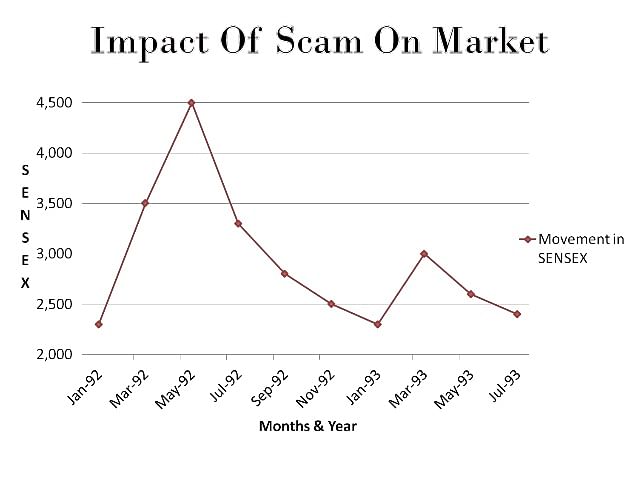By Diksha Mehta-
Harshad Shantilal mehta, the ‘Big Bull’ of the Indian Stock Market was born on 29 July, 1954 in Gujarat, India in a lower middle class Gujarati family and his father was a small businessman.
He was brought up in Maharashtra but moved with his family to Raipur in Chhatisgarh some time later.
In 1976, he came to Bombay in search of work with only Rs.40 in his pocket and from hereon, he did odd jobs for the upcoming 8 years until he landed a job as a salesman in New India Assurance Company Limited (NIACL), Bombay.
EARLY CAREER
During his time at the NIACL, Mehta became interested in the stock market. He quit his job and joined a brokerage firm ‘Harjivandas Nemidas Securities’, headed by a broker named Prasann Pranjivandas, whom he considered his Guru.
Over the course of the next several years, he worked in a number of brokerage firms until he became a member of the Bombay Stock Exchange as a broker and formed his own firm called ‘GrowMore Research and Asset Management’ in 1984. He came to be known as the ‘Amitabh Bacchan of the Stock Market’ by 1990.
1992 SECURITIES SCAM
INITIATION OF THE SCAM
After establishing his firm in 1984, Mehta started trading actively in 1986 and he gained a lot of eminent clients in 1990. The company he traded in initially was the Associated Cement Company (ACC). The shares of the company rose from Rs. 200 to nearly Rs.9000 in a matter of time and he justified it by saying that the stocks were undervalued before, stating his Replacement Cost Theory (valuation of a firm on estimating the cost of establishing it). Little was it anticipated by anyone that this was the start of a fully pre-planned scam!
BACKGROUND OF THE SCAM
The scam was fully orchestrated by Harshad Mehta using Bank Receipts and Stamp Paper which caused the whole securities market to crash leading to a systematic change in all the policies relating to the stock market.
Mehta used securities obtained from the banks against forged cheques signed by corrupt officials. He raised the stock prices through fictitious and mal-practices and sold the stocks of companies to various buyers at immensely high prices. When the scam was uncovered, the stock market hit a downfall and investors lost lakhs of money invested by them.
The index fell from 4500 to 2500 representing a loss of Rs. 100,000 crores in market capitalization. This rapid fall was the largest the stock market had ever seen.[6]
STATUTORY LIQUIDITY RATIO (SLR) AND READY FORWARD DEALS (RFD)
During the 90’s, the banks were not allowed to invest in the stock market. Also, they were required to maintain government fixed interest bonds. These bonds were issued by the government to secure finance from the banks for developing infrastructure of the country.
The minimum threshold that the banks had to maintain as bonds in the 1990s was set at 38.5%. This minimum percentage that banks have to maintain in the form of bonds or other liquid assets is known as the Statutory Liquidity Ratio (SLR).[7]
The banks sometimes face a surge in the Net demand and Time Liabilities when they are required to increase their bond holdings.[8] During these times, instead of buying new bonds, the banks use liquid securities- the Ready Forward Deals (RFD). RFD’s are short term loans (15 days) that one bank can take from another bank. In case of RFD’s, instead of using the government bonds as collateral, the banks issue ‘Bank Receipts’ (BR).
The bank receipts were used as buying and selling of securities. This means that when one bank needed a loan, it would sell a BR to another bank for a price and after the period of 15 days was over, the borrower bank would buy its BR back from the lending bank at a higher price.
The difference in the buying and selling price was considered as the interest amount. Now, according to the RBI, the use of Bank receipts was not allowed however, due to discrepencies in the system all of this went on under its nose.
ROLE OF BROKERS AS MIDDLEMEN
The brokers emerged as middlemen in all the transactions carried out by the banks regarding RFD’s and the BR’s. Initially, their role was only to act as intermediary between two banks- to facilitate their meeting.
However, with time they started to buy and sell the securities on behalf of the banks. The borrowing and lending banks did not enter into transaction directly, but through the brokers.
It served a good purpose to them as the transactions took less time to be conducted, there was secrecy in the transactions and the credit worthiness of one bank mattered less to the other.
ROLE OF HARSHAD MEHTA
Harshad Mehta was himself a broker in all these deals. He acted as a middleman between two banks and convinced them to transfer the securities amount in his name.
Then he used this amount to invest in the stock market, especially his favourite banks to increase their share price; Associated Cement Company (ACC), Apollo Tyres, Reliance, Hero Honda, Tata Iron and Steel Co (TISCO), BPL, Sterlite, and Videocon were some of them.
Usually, in an RF deal, there were only two banks involved. However, being the mastermind he was, Mehta used to grope numerous other banks, taking money from one bank and repaying the other, and so on.
BEAR CARTELS AND HARSHAD MEHTA
In the stock market, bears are those who identify problematic companies and short-sell them. Short selling means that traders sell the shares of a particular company without owning them.
They can do this by borrowing shares from other shareholders or by going short in the futures market. To create maximum impact on the share prices, the traders create a group termed as a bear cartel. Since the bears attack a particular stock or group of stocks in order to gain from the fall in price, the action is performed normally in times of stress and bad market conditions.[9]
During that time, the bear cartels used to lower the share price of certain companies, buy them and then sell them later at high profits. They too operated on money stolen from banks.
Harshad Mehta did just the opposite of what they did. He used to keep pumping money into the market to stop the stock prices from falling down. Although the banks were aware of his actions, but they kept their mouths shut because Mehta transferred a certain amount of his profits to their accounts.
THE SCAM WITHIN THE SCAM !
With time, Mehta realised further loopholes in the system and decided to exploit them. He, alongwith two other banks, namely Bank of Karad (BOK) and the Metropolitan Co-operative Bank (MCB) forged BR’s.
These BR’s were without securities, which is equivalent to taking loans from banks without any collateral. He took more money using these BR’s and invested in the market.
Now, although it was the duty to the RBI to conduct audits and inspections of the banks including the ones mentioned above, all these activities went on either undetected or ignored by the RBI. Apart from the above method of scamming, fake government bonds were also forged to take small amounts of money from the banks.
EXPOSING THE HARSHAD MEHTA SCAM
Journalist Sucheta Dalal was highly intrigued by the luxurious lifestyle of Harshad Mehta- a common broker.

It was common knowledge that Mehta onwed a 12,000 sq.ft. Worli Penthouse and high end cars like Toyota Corolla, Lexus Starlet, and Toyota Sera which were a dream for even the rich people at that time.
Sucheta Dalal investigated his source of wealth and exposed him in a Times of India column on 23rd April, 1992. She described how he robbed the SBI of Rs.500 Crores through his dubious activities.
It was alleged that the bear cartels got together and blew a whistle on his activities to take him out of the picture. She even co-authored a book “The Scam: Who Won, Who Lost, Who Got Away” with Debashis Basu.
AFTERMATH OF THE SCAM
FALL OF MARKET INDEX
Following the exposure, the SBI realised that it held Rs.500 Crore worth bank receipts which held no value. All the banks that held such receipts carried out audits and realised how much money they had lost in the scam. The market crashed after all the banks and investors started demanding their money back. All of this went on until June, 1992.
The market index plunged to such a low that had not been seen in a long time. The lapses in the security of the financial system were realised which led to a substantial change in all the financial policies of banks and the RBI. News of the scam spread throughout the world and several international banks including Standard Chartered and ANZ Grindlays were implicated. It was alleged that ANZ Grindlays transferred huge amounts of money into Mehta’s personal account.
 [10]
[10]
FURTHER INVESTIGATION BY CBI
Further investigation revealed that officials of many banks were involved in perpetrating the crime mainly from Financial Fairgrowth Services Limited (FFSL) and Andhra Bank Financial Services Ltd (ABFSL).
The Chairman of Vijaya Bank committed suicide following the revelations. Even former Union Minister P. Chidambaram resigned from his post after allegations against him that he owned shell companies related to Mehta.
FRAMING OF CHARGES, TRIAL AND CONVICTION
A committee called Janakiraman Committee was formed to look into the scam by the RBI.
As per its report, the scam was of the magnitude of Rs.4025 crore. CBI registered several cases against the group of brokers (Harshad Mehta group, Hiten Dalal group, Bhupen Dalal group, Ajay Kayan group) for defrauding the banks in the names of securities transactions and chargesheeted those cases. CBI, BS & FC, Mumbai Branch registered 17 cases, out of which 15 were chargesheeted. Of these 15, 11 cases have been disposed off by the TORTS Court in Mumbai.[11]
Harshad Mehta, alongwith his brothers Ashwin and Sudhir were arrested by the CBI in November, 1992 and their properties were attached.
However, they were released three months later on bail. Mehta also alleged that he paid Rs. 1 Crore as bribe to the then Prime Minister P.V. Narsimha Rao to let him off the hook which could not be proved.
A life-long ban was imposed on Mehta by the SEBI. It took a long time for the CBI to collect evidence against Mehta and finally in October 1997, a special court was set up to hear all the cases against him.
A total of 72 criminal charges were framed against him but he was convicted for only 34 of them. In September 1999, he was awarded 5 years rigorous imprisonment and Rs.25, 000 fine alongwith 3 others for defrauding Maruti Udyog Ltd. of Rs.380.97 million. But he got bail in all the cases related to him.
Later in 2001, he was arrested again for misappropriating Rs. 2.5 million from 90 blue-chip companies and denied bail. He passed away due to cardiac arrest on 31 December, 2001 in Tihar Jail where he was kept in judicial custody.
His appeal in the MUL case was dismissed by the Supreme Court in 2003 and all remaining criminal cases against him were abated by the Court due to his death but the civil suits of compensation were maintained.
STATUS OF THE SCAM TODAY
Adjusting today’s inflation, the amount involved in the scam is estimated to be Rs.24, 000 Crores which is an all time high of all the scams committed in India till date. In a report of the Office of the Custodian released on 8 January, 2016 the Harshad Mehta family has assets worth Rs 1,723.84 crore and has total liabilities of Rs 16,044 crore.
But this claim was refuted by his brother Ashwin during a hearing in the Supreme Court. Some of Mehta’s assets as well as his associates assets were sold by the authorities in an auction and reimbursement were made to various victims of the scam.
However, an additional Rs.2000 crores worth of assets are yet to be auctioned. Recently, on 12 April 2017, a special judge convicted four former bank officials to 3 year imprisonment and Rs.5000 fine in the scam.
In February 2019, the Income Tax Tribunal freed the Mehta family of over Rs.2000 Crores income tax demand.
CONCLUSION
The main accused Harshad Mehta is dead and so are many of the accused over the past decades. All documents and witnesses have become outdated and no one person can be blamed for it.
Many financial experts believe that he did not commit any fraud, and only exploited the loopholes in the system and some believe that he was scapegoated as someone had to be blamed for it all.
It may be opined that although the victims of the scam are being paid their money back through selling of his assets, but all the money may never be recovered in many years to come.
It has been more that 25 years since the scam was first exposed, but its effect can still be felt by many people who suffered at that time!
-
Retrieved from https://en.wikipedia.org/wiki/1992_Indian_stock_market_scam. ↑
-
Retrieved from https://tradebrains.in/harshad-mehta-scam/. ↑
-
Ibid. ↑
-
Retrieved from https://www.livemint.com/Money/NCy5iFxNOl083C5V4Qj3aK/Dejargoned-Bear-cartel.html. ↑
-
Retrieved from http://www.cbi.gov.in/fromarchives/harshadmehta_nw/harshadmehta.php. ↑
-
Retrieved from https://en.wikipedia.org/wiki/1992_Indian_stock_market_scam. ↑
-
Retrieved from https://tradebrains.in/harshad-mehta-scam/. ↑
-
Ibid. ↑
-
Retrieved from https://www.livemint.com/Money/NCy5iFxNOl083C5V4Qj3aK/Dejargoned-Bear-cartel.html. ↑
-
Retrieved from https://www.thequint.com/explainers/where-is-the-rs-24000-crore-lost-in-the-harshad-mehta-securities-scam. ↑
-
Retrieved from http://www.cbi.gov.in/fromarchives/harshadmehta_nw/harshadmehta.php. ↑
Pic Credit- 1. Bullswaves.com
2. Sony Liv


